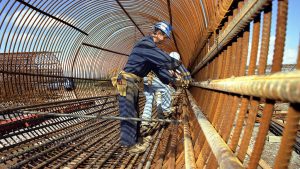Ontario’s unionized building trades are close to establishing a new process for resolving jurisdictional disputes (JDs), delegates at the annual meeting of the Provincial Building and Construction Trades Council of Ontario were told recently.
Representatives of the Building Trades member unions as well as non-members of the council including representatives of the Carpenters’ Union, the International Union of Operating Engineers and the Labourers’ International Union of North America (LIUNA) met over two days, Sept. 13 and 14, to hammer together the process.
Former Ontario Labour Relations Board (OLRB) chair Mort Mitchnick, one of two facilitators who brought the union leaders together, explained the new system would include a standing committee with building trades panellists who would identify “hot spots” and attempt to “push” the affiliates to sit down and develop “broader peace agreements,” and an alternate dispute resolution (ADR) process, with referees who would attempt to resolve particular JDs.
“We believe this is a very positive step forward,” said John Grimshaw, executive secretary treasurer of the International Brotherhood of Electrical Workers Construction Council of Ontario and a Building Trades board member.
“Right now we go to the OLRB and spend a ton of money, a lot of times in a futile attempt to get jurisdiction on something that should or should not be theirs, and generally speaking come out of the labour board without getting a decision, you get some kind of settlement, and the problem continues,” said Grimshaw.
“Hopefully through this, if we can get people to buy in, even if only three or four trades, I think it is a positive step.”
While the Carpenters’, Operating Engineers and LIUNA participated in the reconciliation process, none have yet agreed to sign on to the new standing committee system.
Mike Gallagher, business manager of the Operating Engineers, said they “have not yet reached a decision whether we will participate in the future or not.”
Mike Yorke, president of Local 27 of the Carpenters’, said his group is taking a wait-and-see approach and was “not dismissing it out of hand.”
LIUNA did not respond to requests for comment as of press time.
Fighting with each other doesn’t do anything except erode market share
— John Grimshaw
International Brotherhood of Electrical Workers Construction Council of Ontario
The reconciliation process was launched at the Building Trades annual conference last year when delegates passed a resolution urging parties to work together to resolve JDs. Mitchnick, now a labour arbitrator, and construction economist John O’Grady were recruited as facilitators.
Building Trades business manager Patrick Dillon has been selected by the participants to set up the standing committee and take the process to the finish line, when final signatures to the deal will be sought.
“We’ve just got some work to do now to take it a little further and get people willing to use it,” he explained. “My job now is to get the standing committee set up, I will have to talk to the trades and Mr. Mitchnick and get an idea what kind of expertise we need on the standing committee.”
Mitchnick will remain involved. He described the ADR as a “quick way of resolving disputes that parties can’t resolve on their own.
“Other provinces have done that,” he said. “We will set up a process with expertise in construction so they can answer the easy questions quickly.
“Everyone knows what core (jurisdiction) is. We are trying to get a process that can suss out what it means to be an electrician without fighting about what’s on the periphery of being an electrician versus being a labourer or a pipefitter or anything else that may overlap with it.”
Dillon said streamlining resolution of JDs would pave the way to creating more jobs in the sector.
Grimshaw commented, “Fighting with each other doesn’t do anything except erode market share. Clients don’t want to see that. It has been a problem.”
Mitchnick said next steps beyond setting up the standing committee and ADR process are to get as many trade unions as possible to sign on to the finalized structure, possibly including those outside the Building Trades council; to get buy-in from the OLRB; and ultimately to get employers onside with ideally the new jurisdictional agreements forming part of collective agreements.
“We’ll be trying to get respect from the labour board for it and we think there is a very good chance of getting respect for it,” he said. “Given all the disparate interests in the trade groups, with this kind of process that they are prepared to live with and abide by, then why shouldn’t the labour board give it a lot of weight.”
Grimshaw said, “Again, we’ll have to walk before we run. If we get it set up and we get a couple of test cases and it actually works well, I think it will grow, and we’ll get better buy-in.”











Recent Comments
comments for this post are closed